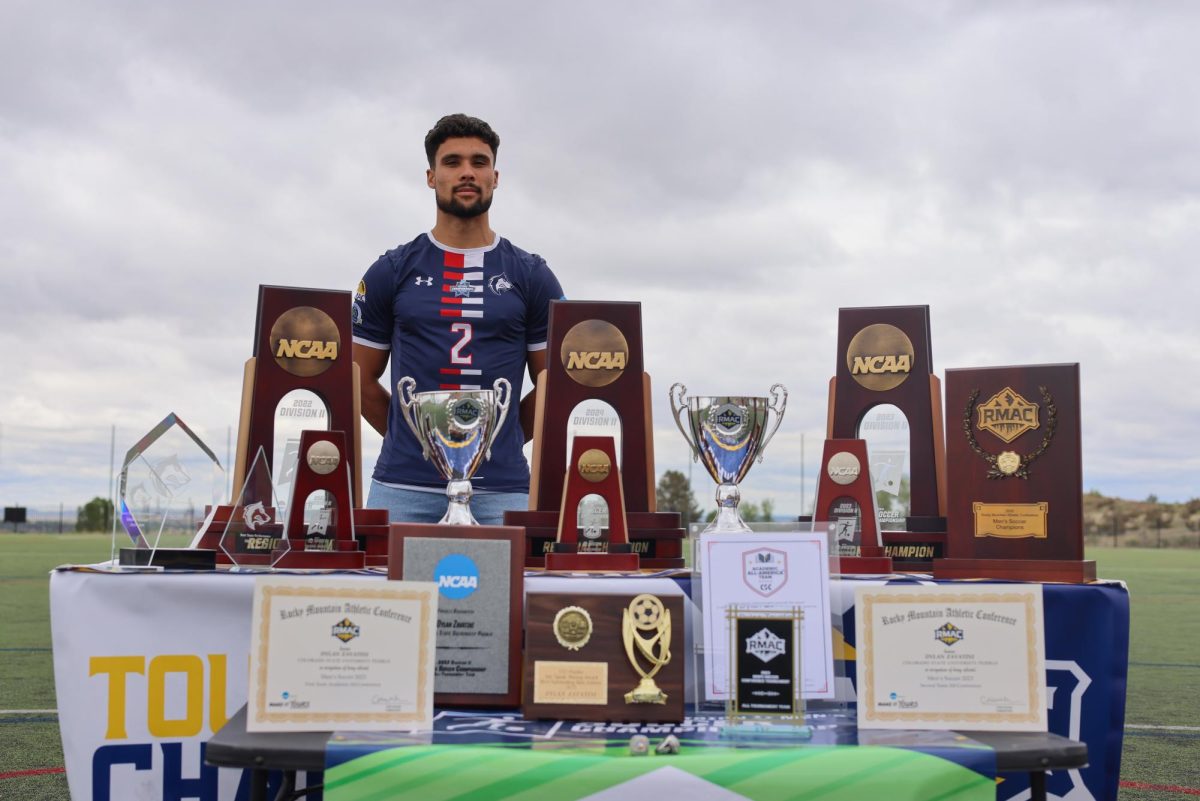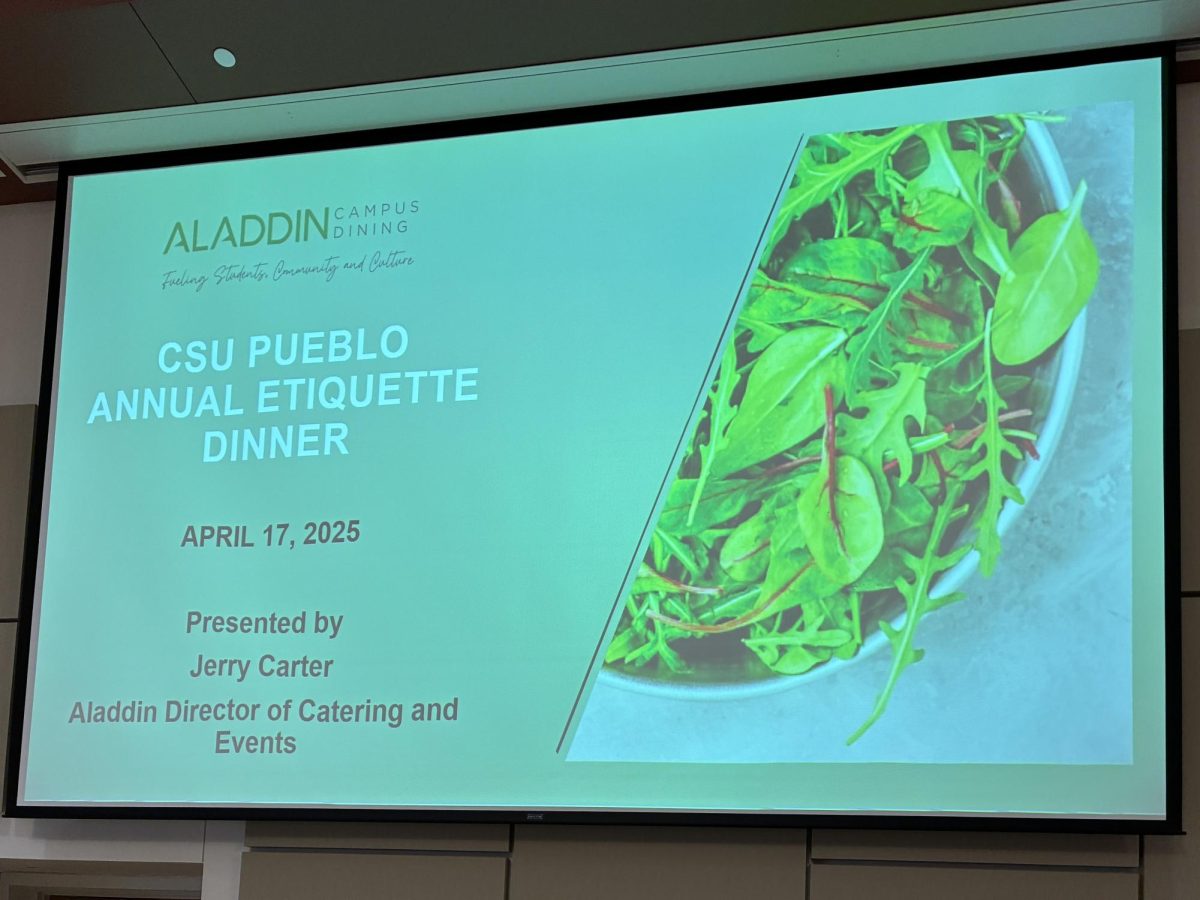
By Nikki Martinez
The Reserve Officers’ Training Corps program, offered through the military science department at CSU-Pueblo, presents a challenge to its students unrivaled by any program on campus.
The intensive physical aspects of the program, mile long morning runs, tactical training and physical fitness tests are equally matched by the mental preparedness the cadets are taught to include Army organizations ,weapons systems, critical decision making process, stress management, map reading and land navigation skills, among others.
When ROTC cadets graduate from the program, they enter the military as an Army officer in the rank of Second Lieutenant. This rank is given to them because of their successful completion of the ROTC program while earning their college degree, said Lt. Col. Milton Hodge, one of the instructors in the ROTC program.
Cadets are ranked as MS1s, 2s, 3s or 4s by their year in the program as in MS1s are freshman in the program and so on. This rank system also reflects the credits received by a cadet at any given level. MS1s only receive one credit hour per course, MS2s receive two and MS3s and MS4s receive three credit hours for their courses.
The instructors, or cadre as they are called, are assigned to one rank within a specific military science level. Lt. Col. Hodge is the instructor to MS3s; Sgt. 1st Class Andrei Williamson instructs MS1s; Sgt. 1st Class Gener Molina serves as instructor to MS2s; and Lt Col. William Ryan instructs the MS4 ranking cadets.
MS4s, unlike lower ranking cadets in the program, act as peer instructors to the MS1s, 2s and 3s. The MS4s attend courses off the CSU-Pueblo campus at the University of Colorado at Colorado Springs.
The first two years of Military Science courses are open to all CSU-Pueblo students. However, only those cadets who meet the criteria are contracted. To be contracted, a cadet must pass the Army Physical Fitness test, meet the Army height and weight standards, pass the Army Medical Evaluation, possess a GPA of 2.5 or higher and obtain a recommendation from their ROTC instructor.

“In addition to the tangible criterion, we also look for unique leader traits. How well does a cadet deal with stress, perform in adverse weather conditions or function with limited sleep?”
“Contracting is a big step in the cadet’s life. It means that their dream of becoming an officer is closer to becoming a reality,” Hodge said.
Once the cadets are contracted, it shows that the cadet commits to completing the program and takes the cadet oath. The oath states:
“I, (state your name), do solemnly swear (or affirm) that I will support and defend the Constitution of the United States against all enemies, foreign and domestic; that I will bear true faith and allegiance to the same; and that I will obey the orders of the President of the United States and the orders of the officers appointed over me, according to regulations and the Uniform Code of Military Justice. So help me God.”
The students who continue in the program until their senior year are the cadets who will go on to excel in the military Lt., Col. Hodge said.
Although many of the cadets in the program enter after high school in their freshman year of college, the program is also offered to prior service cadets. Among others, Cadet Dacren Walker and Cadet Adrienn Halland, a political science major, both served in the military abroad before their time at CSU-Pueblo.
Walker, MS3, is an active duty member of the Army and has served one tour in Afghanistan.
He was inspired to join the military on 9/11 and though his active duty time is now spent in college courses, Walker still holds with him his reason for joining the armed forces.
“My teacher was crying at her desk,” Walker said of the day his life course changed. “I asked her what was wrong, and she said terrorists had hit the World Trade Center.”
“Up until that point life was just fun, and at that point I knew life wasn’t always going to be like that,” Walker said. “That gave my life a path.”
Walker then signed up for the Army at 17 in his junior year of high school and left for basic training two weeks after he graduated in 2005.
From June 2009 to December 2009, Walker was stationed in Afghanistan as a staff sergeant in the Army. He submitted an officer’s packet to be admitted into the ROTC program and was brought back to the states when he was accepted.
CSU-Pueblo was a military-friendly school in that the university accepted all 60 of Walker’s credits attained through online schooling while he was abroad.

Though the change of pace from active duty to ROTC member was frustrating, he enjoys the program, and likes to serve as somewhat of a mentor to the cadets, Walker said.
ROTC scholarships for prior service cadets also help them to gain a college degree while remaining a member of their military branch.
Halland, an MS2, attends the university on the Green to Gold Scholarship which provides enlisted active duty Army members with the opportunity to complete their bachelor’s degree and obtain a commission through participation in the ROTC program, according to the CSU-Pueblo ROTC program pamphlet.
Halland served in Iraq from May 2004 to May 2005, went back from September 2006 to December 2007 and made a final tour from January 2009 to January 2010.
Halland’s innate initiative and the discipline she’s gained as a member of the Army have lent to her ability to lead on campus. She is the head of two political science study groups on campus which she started to benefit her and her fellow political science students.
Like Walker, Halland said she feels as though her prior service time has given her a unique perspective to share with her fellow cadets.
Freshman cadet Joseph Perry, an outdoor leadership and recreation major, said he feels the prior service cadet’s experience and leadership skills are helpful in the ROTC experience.
“When you work with prior service people, you learn a lot from them,” Perry said. “They let you get a real world view.”
Though many freshman MS1 cadets lack actual military experience, they display the qualities of discipline and dedication to serve in a military branch.
Their “glimpse of the military experience” through ROTC, as Walker puts it, allows them to understand the tactical and physical elements of the military experience, Walker said.
MS1 Cadet Bryce Campbell, a business management major, said the ROTC program has changed his outlook on life.
“It (the ROTC program) has not only helped me physically, it makes you more aware of your image,” Campbell said. “Everywhere you go you have to be conscious of what you’re doing. When you’re studying for something, you’re studying for a cause.”
“Everything you do will have an effect on your future,” Campbell said. “You do everything you can to be a leader.”

The finale to the program is the induction into a military branch at the cadet’s senior year. Unlike any other student on campus, a cadet’s junior to senior summer is when their future career is determined.
The cadets are assigned a career based on their score in the Leadership Development Assessment Course, a five-week summer course to evaluate and train all ROTC cadets held in Fort Lewis, Wash.
Other aspects taken into account in the assessment are a cadet’s community service and volunteer work, their GPA and other aspects reflecting their dedication and morality.
In order to attain the position a cadet aspires for, in Cadet Walker’s case, he aspires to be involved in aviation, specifically a helicopter pilot, they must earn a grade of “Exceptional” on the LDAC rather than a satisfactory or failure, which are the only scores given.
The pressure to excel in the program exists both in the ROTC program itself and in a cadet’s career as a student on campus, said MS1 Nick DiMichele, a freshman history major.
“There’s pressure,” “Not only are you being looked at by your cadre, you are also being looked at by your peers. The prior service people are looking at you. The MS3s and 4s are looking at you. You want to perform well so they know you’re capable.”
The ROTC uniform, the Army Combat uniform, is similar to the uniform worn by active duty Army soldiers but can be distinguished by the ROTC crest worn on the cadet’s left arm.
The uniform, DiMichele said, is regarded as a symbol of leadership among professors and students at CSU-Pueblo. The attire commands respect but also adds the pressure and responsibility of a constant conscientious attitude by the cadet, he said.
“You are held to a higher standard when you’re in that uniform,” DiMichele said. “When you’re known for being in the program you have to be a leader on campus.”
“In class, if you’re wearing your uniform, they think he’s obviously a leader and they put leadership in your hands,” DiMichele said.
However, Perry said with the pressure comes reward, and the ability to make friends within the ROTC program.
“We (the cadets) will meet up on the weekends.” Perry said. “The other day we created an arena football team from the people in our platoon.”
What may be considered as exclusivity is actually a sense of camaraderie earned through the common experience of the ROTC program, Hodge said.
The ROTC crest worn by cadets symbolically represents the qualities needed to be a part of such a strenuous program. On the crest a helmet represent valor, a sword is shown to represent might and the light of knowledge is symbolized by a lamp. Over the crest is the word “Leadership” and below it “Excellence.”
But one word to summarize the cadets in the program is exemplary.
The cadets, whose rigorous physical and mental education is only part of their college experience, carry their responsibility with grace and determination. In fact, in order to remain part of the program they must hold a 3.5 GPA. They also must stay on the course of an academic worksheet, and must graduate on time so that they will be on track to join the military career they were assigned to.
“There is a lot of oversight on their (the cadet’s) behavior,” Hodge said. “We look at all their performance their grades, their behavior. We hold them responsible.”
“The Army expects their officers to lead by examples. We try to instill the value of duty-honor-country in the cadets.”
A cadet’s dedication to the program coupled with their excellence in school work is certainly a feat to be marveled at by students outside of the program.










